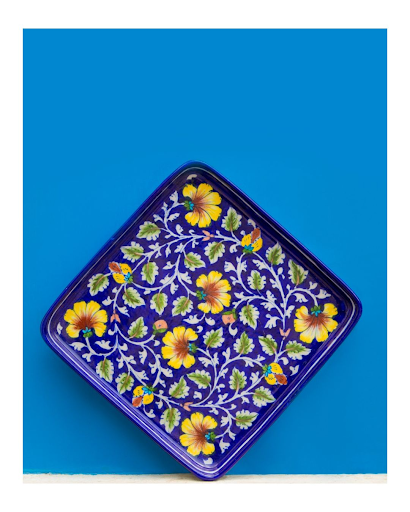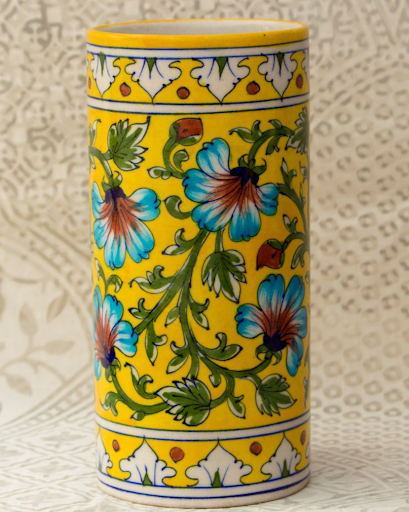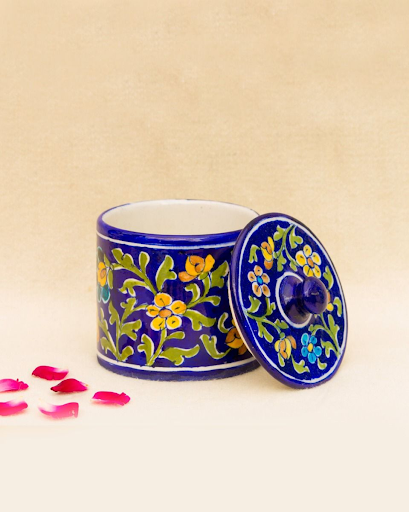History Of Rajasthan's Blue Pottery
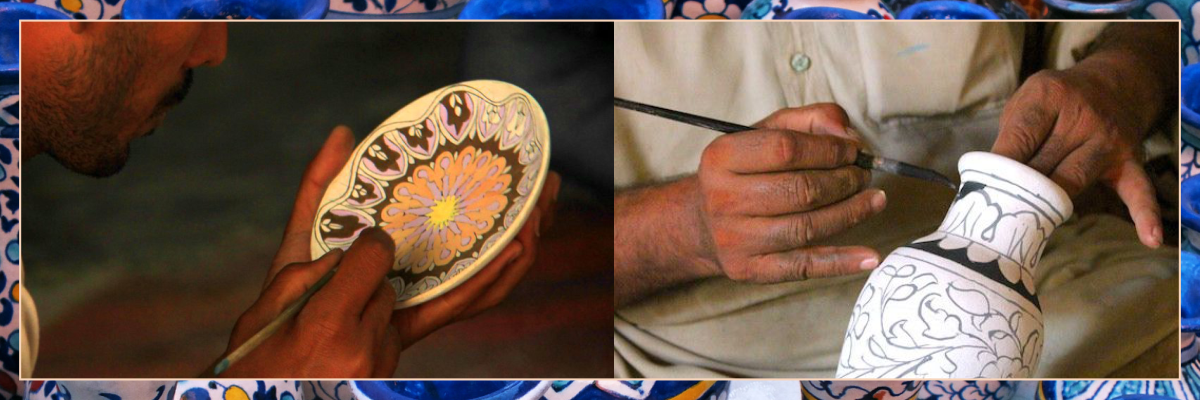
There are many tourist attractions in India, but India’s pink city Jaipur is the most popular tourist attraction. As soon as you enter Jaipur’s city streets, you will feel like you have entered a realm full of unique artifacts. You will find hundreds of handicraft shops, home decor shops, and antique artifacts shops.
The artifacts that you will find in Jaipur will make you realize why it is the best tourist place. Today in this article, we will take a sneak peek into the history of Rajasthan’s most famous and highly adored art, blue pottery.
Rudhigat’s Blue Pottery Floral Tray
The name blue pottery is pretty self-explanatory. The blue dye used while creating the pottery is the reason why the pottery is named blue pottery. Everyone knows that pottery items are made out of special clay, but to your surprise, blue pottery is not made out of clay.
The Origin of the Art of Blue Pottery
The art of blue pottery was first invented in Turkey, and the Turkic invasion of the fifteenth century brought this beautiful pottery art first to northeast India. Later the Afghans invented the blue enamel technique on these ceramic handicrafts and amalgamated Persia’s art skills and China’s varnishing technique. In brief, the Mughals were the ones that brought the art of blue pottery to India.
We all are very much aware that the Mughals ruled the majority of north and south India, but Turkey is situated in our country’s north direction, making north India first in witnessing the blue pottery art.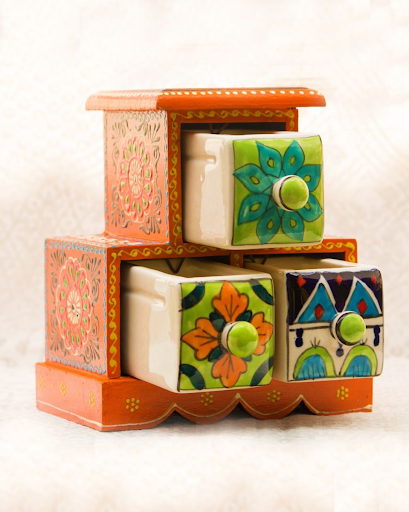
Rudhigat’s Blue Pottery Handcrafted Jewellery Boxes
Following the success of blue pottery art in India, the Mughal rulers boosted their usage. Between the 17th and 18th centuries, blue pottery art spread over the entire Delhi empire and later moved to the Rajput reigns, neighbors to the Mughals. In this way, blue pottery came to Rajasthan.
Tale of Jaipur Becoming Blue Pottery Hub
It's reported that King Sawai Ram Singh II once went to a kite-flying tournament when he saw two brothers from Achnera knock the royal kites of his kite masters to the ground. He was intrigued and sought to learn their secret.
Upon learning that the brothers were potters, he learned that the same blue-green glass that they used to create their pots was used to coat their strings. In order to teach about this distinctive blue-glazed pottery at his new arts and crafts school, Sawai Ram Singh II asked the potters to reside in Jaipur.
The Products and Process Used to Create Blue Pottery
The mixture of raw materials used in creating the paste of blue pottery consists of powdered glass, Multani Mitti, fine powder of Quartz stone, Gond Powder (if needed) and water to give it the perfect consistency. The bright blue and greenish-blue color is obtained by the copper oxide (unrefined) that is added to the dough.
Jaipur blue pottery requires a laborious and prolonged procedure to create. Thepai is a traditional wooden instrument used to flatten the dough into a smooth pancake shape after it has first been prepared by adding various minerals and gums.
Rudhigat’s Blue Pottery Handcrafted Cylindrical Vase
To prevent unintentional distortion, the molds' interiors are filled with ash after the dough has been placed inside them and their edges have been sharpened with knives. Following the ash removal and manual sandpaper polishing of the products' surfaces, the mold is then removed from the material.
After that, the object is covered in a white paste that combines flour, ground quartz, and glass. It is then allowed to dry.
How Recent Trends Changed the Blue Pottery market?
The craft has changed in terms of the kind of raw materials used, how they are processed, how they are designed, and how they are used.
Lead was once a component of the glaze layer, which the craftsmen claimed produced better results. Today, a lead-free glaze is used by artisans to coat objects. The initial motifs on the blue clay pieces were also floral or geometric. Customers today favor cloth or abstract designs.
Rudhigat’s Blue Pottery Multi-Purpose Utility Jar
As a result, the complex, elaborate motifs are being replaced with more straightforward, straight fabric designs. There has been a significant change in the usage in addition to the composition and design trends.
The elements artists once exclusively used for decoration are now also used utilitarianly. They serve as culinary utensils, toothpaste, and pen stands, among other uses. The elimination of lead from blue pottery's glaze is the cause of this. The items couldn't be used as cookware because lead is unhealthy. The use of lead-free articles has expanded to many new fields since their introduction.
Ending Note
In terms of styles, materials, techniques, and forms, as well as even in the manufacturing processes—for instance, the raw materials—blue pottery from Jaipur has seen substantial evolution. Pottery's enamel coating used to contain lead in the past, but no longer. The craftspeople no longer used lead.
Artists are now experimenting with various other materials, such as shades of yellow, red, green, orange, etc. The art is typically done in a strong blue hue, which is its specialty.
The old wood furnace that burned charcoal has also been replaced by diesel heaters in the majority of Rajasthan's areas. The traditional floral and geometric themes give way to ambiguous and abstract designs for tools, motifs, ceramic pots, and other objects. It is incredibly fragile; therefore, handling it requires extreme caution.
Despite these adjustments and mayhem, Jaipur's blue porcelain culture is alive and still as amazing as ever!












